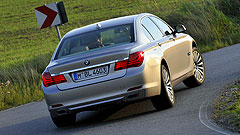Future models - BMW - 7 SeriesSeven ride on the moneyLong gestation: Development work on the latest 7 Series began in 2003. BMW's new 7 Series aims for best-in-class ride quality and handling dynamics14 Oct 2008 BETTER ride quality was critical in BMW’s decision to completely re-engineer its new-generation 7 Series. This is the surprising admission from chief chassis engineer Jörg Ploss at the model’s launch in Germany earlier this month. Involving a seachange in BMW suspension philosophy for the 31-year-old flagship, BMW threw away the old MacPherson struts for a double wishbone design similar to the item found in the X5 and X6 SUVs that the company builds in North America. However, nothing is shared with those 5 Series-derived vehicles, as BMW sought to achieve a different set of driving dynamic goals for a vehicle which must compete against the Mercedes S-class, Audi A8 and Lexus LS. According to Mr Ploss, the new 7’s wishbone design results in a road axis that is parallel with the road instead of more perpendicular to it, vastly improving stability, control and suspension absorption performance. The design allows for optimum adjustment of wheel camber to the road, thus improving tyre-to-road contact significantly, resulting in higher lateral acceleration and better stability properties through corners and when braking. Aiding this are aluminium suspension components, as well as a body stiffness rating that is 60 per cent up on the previous model, and 20 per cent greater torsional stiffness. Combined with a lower centre of gravity, the latest 7 Series is both much better to ride in as well as drive.  Mr Ploss explained that the new double-arm front axle boasts separate wheel guidance and damping functions, which dramatically cuts corruptive forces to the steering and suspension. Mr Ploss explained that the new double-arm front axle boasts separate wheel guidance and damping functions, which dramatically cuts corruptive forces to the steering and suspension.In the rear, the new Integral-V multi-link rear axle features swinging arms with elastokinematic mounts to also counteract conflicting and/or multi-directional impact forces for improved ride and control these also provide an additional buffer against noise and vibration. The new 7 also introduces new electronic dampers that react to both driving style and road conditions thanks to their world-first ability to adjust both the inbound and rebound stage, in a continuous process independently of one another. According to Mr Ploss, BMW is able to tune its luxury limousine for optimum ride suppleness as well as sportier dynamic response – two previously conflicting elements. This is backed up by new, ultra-fast computing processes, as part of BMW’s FlexRay data transmission technology linked to a central control unit, to ensure optimum comfort and control. It can vary ride height instantaneously to counteract body movement according to speed and road conditions. Yet the driver can still choose whichever damper setting is desired, through the BMW’s ‘Dynamic Driving Control’ function, which allows Comfort or Sport from the regular Normal suspension setting. This works on both the damper settings and the threshold of the DSC Dynamic Stability Control, with the latter switch off-able if the driver so wants to. Other chassis-related improvements brought upon the new 7 Series include a slightly better front-to-rear weight distribution rating (around 49:51 front-to-rear), and smaller diameter anti-roll bars (since much of their work is now taken over by the multi-links and trick dampers). The chassis engineers commenced their work on the new Seven in late 2003, with much of the real-world road testing carried out on the roads of France, North America, Scandinavia, the Middle East and Eastern Europe. Finally, BMW tuned the chassis to latest-generation runflat tyres, which are now softer in compound for greater ride absorption qualities. “A blind test with the new-generation runflat tyres revealed that more people chose them over regular tyres for comfort,” Mr Ploss said. As an overall chassis package, the latest 7 Series will be pitched as both the most comfortable and dynamic vehicle in its class, thanks to the new suspension integration. “It offers a level of comfort never seen in a BMW before,” Mr Ploss states. Read more:BMW’s niche-way betFirst drive: Latest BMW limousine is ‘7’ All-mighty First look: BMW’s potent new 7 Series flagship First look: BMW shows 7 Series mild hybrid All future models Alfa Romeo Alfa Romeo Abarth Abarth Audi Audi Aston Martin Aston Martin BMW BMW Bentley Bentley Chrysler Chrysler Chevrolet Chevrolet Dodge Dodge Citroen Citroen Ferrari Ferrari DS DS Ford Ford Fiat Fiat FPV FPV Foton Foton Haval Haval Great Wall Great Wall Honda Honda Holden Holden Hyundai Hyundai HSV HSV Isuzu Isuzu Infiniti Infiniti Jeep Jeep Jaguar Jaguar Lamborghini Lamborghini Kia Kia Lexus Lexus Land Rover Land Rover Mazda Mazda Maserati Maserati Mercedes-Benz Mercedes-Benz McLaren McLaren Mini Mini Nissan Nissan Mitsubishi Mitsubishi Peugeot Peugeot Opel Opel Proton Proton Porsche Porsche Renault Renault Ram Ram Saab Saab Rolls-Royce Rolls-Royce Smart Smart Skoda Skoda Subaru Subaru SsangYong SsangYong Tesla Tesla Suzuki Suzuki Toyota Toyota Volvo Volvo7 Series pricing
Motor industry news |
Click to shareBMW modelsResearch BMW All future models Alfa Romeo Alfa Romeo Abarth Abarth Audi Audi Aston Martin Aston Martin BMW BMW Bentley Bentley Chrysler Chrysler Chevrolet Chevrolet Dodge Dodge Citroen Citroen Ferrari Ferrari DS DS Ford Ford Fiat Fiat FPV FPV Foton Foton Haval Haval Great Wall Great Wall Honda Honda Holden Holden Hyundai Hyundai HSV HSV Isuzu Isuzu Infiniti Infiniti Jeep Jeep Jaguar Jaguar Lamborghini Lamborghini Kia Kia Lexus Lexus Land Rover Land Rover Mazda Mazda Maserati Maserati Mercedes-Benz Mercedes-Benz McLaren McLaren Mini Mini Nissan Nissan Mitsubishi Mitsubishi Peugeot Peugeot Opel Opel Proton Proton Porsche Porsche Renault Renault Ram Ram Saab Saab Rolls-Royce Rolls-Royce Smart Smart Skoda Skoda Subaru Subaru SsangYong SsangYong Tesla Tesla Suzuki Suzuki Toyota Toyota Volvo Volvo7 Series pricing
Motor industry news |














Facebook Twitter Instagram